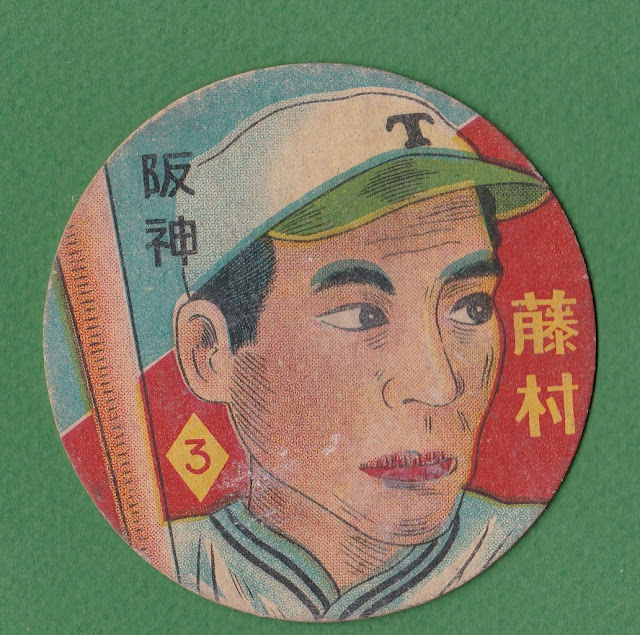Fujimura is an interesting figure in Japanese baseball history. He played his entire career for the Hanshin Tigers from 1936 until 1958. That meant that his playing career encompassed both the very first season of professional baseball in Japan, and also the rookie season of Shigeo Nagashima.
His batting was where he made his biggest mark though. In 1950 he led the league with a .362 batting average and collected 191 hits to set the Japanese version of George Sisler's single season record. It was Fujimura's record that Ichiro broke when he had his 210 hit season for the Blue Wave a few years before he broke Sisler's record with the Mariners.
Like many Japanese players of his generation a very large chunk of Fujimura's prime years were stolen by the war. He entered military service in 1939 and spent most of the war in southeast Asia. He was present at the fall of Singapore and, if his account is true, was the first Japanese soldier to spot the British raising the white flag. Other wartime exploits of his include falling off a cliff in a jungle and suffering an injury so bad they almost amputated his leg, and having to spend a day swimming through shark infested waters after surviving the sinking of a transport ship that had been torpedoed.
Towards the end of his career he served as player-manager for the Tigers. Though the team played well under him he seems to have had a "difficult" relationship with his players. In 1956 a group of them, led by Juzo Sanada and Masayasu Kaneda, demanded that Fujimura be replaced as manager. The team sided with Fujimura, who kept his job, and the incident seems to have ended Sanada and Kaneda's playing careers.
The Fujimura cards I have are pretty cool ones. I particularly like the two round ones which have very striking and colorful artwork on them. I'm having trouble identifying them as they both seem to be from uncatalogued sets. The one pictured at the top of this post has a kind of "bullseye" background on it and there are two similar sets listed in Engel (JRM 47 and JRM 52, from 1948 and 1949 respectively). The coloring and design on those are slightly different though, I haven't seen any with a red and yellow bullseye before. The other circular one has a quite striking look to it, but it is unlike any round menko listed in Engel's guide.
The rectangular one in contrast is easier to identify, its from JCM 92, issued in 1948. The artwork is a bit cruder than on the other two but I like it!



Nice! I have a handful of his cards from the 40's and 50's along with some more modern cards of him.
ReplyDeleteI find the experiences of Japanese baseball players in the War to be endlessly fascinating. Hiroshi Ohshita was slated to be a kamikaze pilot but the war ended before he had to sacrifice himself. Shigeru Mizuhara spend several years in a Soviet POW camp and wasn't released until several years after the war ended. Eikichi Nagamochi took part in the Pearl Harbor attack. And of course, five year old Isao Harimoto survived the atomic bombing of Hiroshima. He's the only Hibakusha to play professional baseball.
Yeah, these guys have some pretty amazing survival stories. When I read their English bios on Wikipedia they usually don't mention any of that, but when you look up their Japanese ones you find those "swam all day in shark infested waters after boat torpedoed", "had atomic bomb dropped on him, survived", "Kamikaze pilot saved by the end of the war" tidbits that are so fascinating.
DeleteThe Americans were very cautious with their famous athletes, but Japan handled things differently. Eiji Sawamura, to take one famous example, didn't even make it through the war. I wonder if he would be regarded with the same sort of reverence if he had had a long career and gradually faded to irrelevance in the late 1950s, instead of dying suddenly in his mid-20s. (Although it was just arm trouble and not violent death, I wonder the same thing about Koufax.)
ReplyDeleteMy pet theory about why two-way players were more common in early Japanese ball is that the level of competition was lower then, and, in general, two-way players are more common when the level of competition is lower. If your competitors aren't that good, it's easier to get away with hitting and pitching just on the basis of sheer athleticism. Think about how many high school guys are dual SS/P. Makes what Ohtani is doing all that much more impressive.
The US also had the "luxury" (if one can call if that) of being on the winning side, so they could spare their top athletes and celebrities from frontline service more than Japan did (though a few guys did, like Warren Spahn, albeit before he became a star).
DeleteThat is probably true about competition being a bit lower, at least in the sense of technical skill levels being less advanced and thus needing less specialization. Its like when you see side by side comparisons of Olympic gold medal performances in Gymnastics from the 1950s compared to today and it looks like the 1950s performances are those of low level beginners by current standards.
I wonder if any other baseball player has broken the same record in two different countries/leagues? I vividly remember Ichiro breaking Sisler's record, but had never heard about his breaking this guy's in Japan.
ReplyDeleteThat is an interesting question. Ichiro is I think in a unique category that way, at least in terms of "big" records.
Delete